Trebuchet
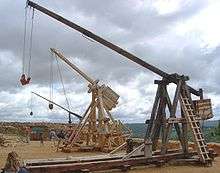
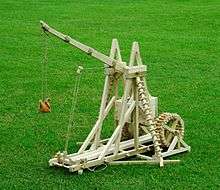
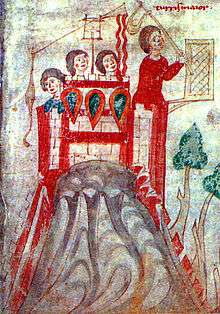
A trebuchet[nb 1] (French trébuchet) is a type of siege engine most frequently used in the Middle Ages. It is sometimes called a counterweight trebuchet or counterpoise trebuchet, to distinguish it from an earlier weapon called the traction trebuchet, where men pulling ropes provided the power.
The counterweight trebuchet appeared in both Christian and Muslim lands around the Mediterranean in the 12th century. It could fling projectiles weighing up to 350 pounds (160 kg) at or into enemy fortifications. Its use continued into the 15th century, well after the introduction of gunpowder.
Basic design
The three distinguishing characteristics of a trebuchet are:
- The trebuchet is a compound machine—a combination of simple machines. The trebuchet makes use of the mechanical advantage of a lever. Most trebuchets are powered exclusively by the force of gravity. Potential energy is stored by means of an extremely heavy weight box attached (by a hinged connection) to the counterweight portion of the throwing arm. Some earlier trebuchets stored potential energy as traction force (traction trebuchets).
- When the trebuchet is fired, the weight box is permitted to fall and the force of gravity causes rotational acceleration of the attached throwing arm around the axle (the fulcrum of the lever). The throwing arm is usually four to six times the length of the counterweight portion. These factors multiply the acceleration transmitted to the throwing portion of the arm and its attached sling.
- The sling is affixed to the end of the throwing portion of the throwing arm (opposite the counter weight portion). The sling contains the projectile and transmits the forces generated at the end of the throwing arm to the projectile. The sling also changes the trajectory, so that, at the time of release from the sling, the projectile is traveling in the desired speed and angle to give it the range to reach the target.
The Couillard is a smaller version with a single stem or platform instead of the usual double "A" frames. The counterweight is split into two halves to avoid hitting the center stem.[3]
Design evolution
The earliest form of trebuchet, often called the traction trebuchet, utilized the power of the human body to pull down on the lever arm to launch the desired projectile. However, this was eventually deemed an inefficient method of warfare, which motivated ancient engineers to update the design. The next step in the development of this siege engine was the invention of the fixed counterweight trebuchet. Ancient armies directly utilized gravity to launch projectiles at their enemies by placing a large weight on the short end of the trebuchet's lever arm and then letting it fall. This was a more efficient and powerful machine than the traction trebuchet because it reduced the number of men needed to operate it and could be fired repeatedly without wearing out. As societies advanced, so did the trebuchet's design. While the fixed counterweight trebuchet was devastatingly effective, it was subject to a great deal of fatigue stress during operation. This led to a shortened operational life cycle. The counterweight was eventually placed upon a hinge. This allowed the counterweight to swing as it reached the bottom of its fall, thus reducing the stresses placed upon the frame and throwing arm. Not only did this improvement increase the usable life of the machine, but by propping the counterweight up on the hinge, the total distance traveled increased. By increasing the distance the counterweight fell, ancient engineers also increased the rotational speed of the lever arm. This, in turn, increased the launch speed and impact force of the projectile.
History
Traction trebuchet


The trebuchet derives from the ancient sling. It originated in China.[4][5][6] A variation of the sling, called staff sling (Latin: fustibalus), contained a short piece of wood to extend the arm and provide greater leverage. This evolved into the traction trebuchet in which a number of people pulled on ropes attached to the short arm of a lever that has a sling on the long arm. This type of trebuchet was smaller and had a shorter range, but was a more portable machine and had a shorter cycle time than larger, counterweight-powered types. The smallest traction trebuchets could be powered by the weight and pulling strength of one person using a single rope, but most were designed and sized for between 15 and 45 men, generally two per rope. These teams would sometimes be local citizens helping in the siege or in the defense of their town. Traction trebuchets had a range of 100 to 200 feet (30 to 61 m) when casting weights up to 250 pounds (110 kg).
It is believed that the first traction trebuchets were invented by the Chinese sometime before the 4th century BC.[5][6] The first traction trebuchets may have been used by the Mohists in China as early as 4th century BC, descriptions of which can be found in the Mojing (compiled in the 4th century BC). At the Battle of Caishi in 1161, trebuchets operated by Song Dynasty soldiers fired bombs of lime and sulphur against the ships of the Jin dynasty navy during the Jin–Song wars.[7][8] Recent work showed that the traction trebuchet was transferred to the eastern Mediterranean by the late 6th century during the Northern Zhou or Sui dynasty.[4]
The traction trebuchet next appeared in Byzantium. The Strategikon of Emperor Maurice, composed in the late 6th century, calls for "ballistae revolving in both directions," (Βαλλίστρας έκατηρωθεν στρεφόμενας), probably traction trebuchets (Dennis 1998, p. 99). The Miracles of Saint Demetrius, composed between 610 and 620 AD by John I, archbishop of Thessalonike, clearly describe traction trebuchets in the Avaro-Slav artillery: "Hanging from the back sides of these pieces of timber were slings and from the front strong ropes, by which, pulling down and releasing the sling, they propel the stones up high and with a loud noise." (John I 597 1:154, ed. Lemerle 1979)
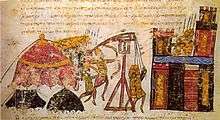
They were also used with great effect by the Islamic armies during the Muslim conquests. A surviving Arab technical treatise on these machines is Kitab Aniq fi al-Manajaniq ( "كتاب الأنيق في المنجنيق", An Elegant Book on Trebuchets), written in 1462 by Yusuf ibn Urunbugha al-Zaradkash. It provides detailed construction and operating information.
There is some doubt as to the exact period in which traction trebuchets, or knowledge of them, reached Scandinavia. The Vikings may have known of them at a very early stage, as the monk Abbo de St. Germain reports on the siege of Paris in his epic De bello Parisiaco dated about 890 AD that engines of war were used. Another source mentions that Nordic people or "the Norsemen" used engines of war at the siege of Angers as early as 873 AD.
Hand-trebuchet
The hand-trebuchet (Greek: cheiromangana) was a staff sling mounted on a pole using a lever mechanism to propel projectiles. Basically a one-man traction trebuchet, it was used by emperor Nikephoros II Phokas around 965 to disrupt enemy formations in the open field. It was also mentioned in the Taktika of general Nikephoros Ouranos (c. 1000), and listed in De obsidione toleranda (author anonymous) as a form of artillery.[9]
Counterweight trebuchet

.jpg)
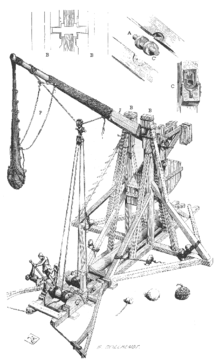

The first record of a counterweight trebuchet was in the 12th century from Mardi ibn Ali al-Tarsusi while talking of the conquests of Saladin.[10] The next record of the counterweight trebuchet appears in the work of the 12th century Byzantine historian Niketas Choniates. Niketas describes a trebuchet used by Andronikos I Komnenos, future Byzantine emperor, at the siege of Zevgminon in 1165 which was equipped with a windlass, an apparatus which was required neither for traction nor hybrid trebuchets to launch missiles.[11] Chevedden dates the invention of the new artillery type back to the Siege of Nicaea in 1097 when the Byzantine emperor Alexios I Komnenos, an ally of the besieging crusaders, was reported to have invented new pieces of heavy artillery which deviated from the conventional design and made a deep impression on everyone.[12]
The dramatic increase in military performance is for the first time reflected in historical records on the occasion of the second siege of Tyre in 1124, when the crusaders reportedly made use of "great trebuchets".[13] By the 1120–30s, the counterweight trebuchet had diffused not only to the crusader states, but probably also westwards to the Normans of Sicily and eastwards to the Great Seljuqs. The military use of the new gravity-powered artillery culminated in the 12th century during the Siege of Acre (1189–91) which saw the kings Richard I of England and Philip II of France wrestle for control of the city with Saladin's forces.[14]
The only pictorial evidence of a counterweight trebuchet in the 12th century comes from an Islamic scholar, Mardi bin Ali al-Tarsusi, who wrote a military manual for Saladin c. 1187.[10][14] He describes a hybrid trebuchet that he said had the same hurling power as a traction machine pulled by fifty men due to "the constant force [of gravity], whereas men differ in their pulling force." (Showing his mechanical proficiency, Tarsusi designed his trebuchet so that as it swung it cocked a supplementary crossbow, probably to protect the engineers from attack.)[15]
During the Crusades, Philip II of France named two of the trebuchets he used in the Siege of Acre in 1191 "God's Stone-Thrower" and "Bad Neighbor."[16] During a siege of Stirling Castle in 1304, Edward Longshanks ordered his engineers to make a giant trebuchet for the English army, named "Warwolf". Range and size of the weapons varied. In 1421 the future Charles VII of France commissioned a trebuchet (coyllar) that could shoot a stone of 800 kg, while in 1188 at Ashyun, rocks up to 1,500 kg were used. Average mass of the projectiles was probably around 50–100 kg, with a range of c. 300 meters. The cycle rate could be noteworthy: at the siege of Lisbon (1147), two engines were capable of launching a stone every 15 seconds. Also human corpses could be used on special occasion: in 1422 Prince Korybut, for example, in the siege of Karlštejn Castle shot men and manure within the enemy walls, apparently managing to spread infection among the defenders. The largest trebuchets needed exceptional quantities of timber: at the Siege of Damietta, in 1249, Louis IX of France was able to build a stockade for the whole Crusade camp with the wood from 24 captured Egyptian trebuchets.
Counterweight trebuchets do not appear with certainty in Chinese historical records until about 1268, when the Mongols laid siege to Fancheng and Xiangyang. At the Siege of Fancheng and Xiangyang, the Mongol army, unable to capture the cities despite besieging the Song defenders for years, brought in two Persian engineers who built hinged counterweight trebuchets. These engines were called by the Chinese historians the Huihui Pao (回回砲)("huihui" means Muslim) or Xiangyang Pao (襄陽砲), because they were first encountered in that battle. After Aju asked Kublai, the Emperor of the Mongol Empire, to help him with the powerful siege machines of the Ilkhanate, Ismail and Al-aud-Din from Iraq arrived in South China to construct a new type of trebuchet. These Persian engineers built mangonels and trebuchets for the siege.[17] Chinese and Muslim engineers operated Artillery and siege engines for the Mongol armies.[18] The design was taken from those used by Hulegu to batter down the walls of Baghdad. The Chinese were the inventors of the traction trebuchet, but now they faced Muslim-designed counterweight trebuchets in the Mongol army. The Chinese responded by building their own counterweight trebuchets.[19]
With the introduction of gunpowder, the trebuchet lost its place as the siege engine of choice to the cannon. Trebuchets were used both at the siege of Burgos (1475–1476) and siege of Rhodes (1480). One of the last recorded military uses was by Hernán Cortés, at the 1521 siege of the Aztec capital Tenochtitlán. Accounts of the attack note that its use was motivated by the limited supply of gunpowder. The attempt was reportedly unsuccessful: the first projectile landed on the trebuchet itself, destroying it.[20] In 1779, British forces defending Gibraltar, finding that their cannons were unable to fire far enough for some purposes, constructed a trebuchet. It is unknown how successful this was: the Spanish attackers were eventually defeated, but this was largely due to a sortie.
Modern use
Recreation and education
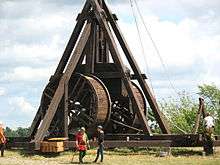
Most trebuchet use in recent centuries has been for recreational or educational, rather than military purposes. New machines have been constructed and old ones restored by living history enthusiasts, for historical re-enactments, and use in other historical celebrations. As their construction is substantially simpler than modern weapons, trebuchets also serve as the object of engineering challenges.[21][22]
The trebuchet's technical constructions were lost at the beginning of the 16th century. In 1984, the French engineer Renaud Beffeyte made the first modern reconstruction of a trebuchet, based on documents from 1324.[23]
The largest currently-functioning trebuchet in the world is the 22-tonne machine at Warwick Castle, England. Based on historical designs, it stands 18 metres (59 ft) tall and throws missiles typically 36 kg (80 lbs) up to 300 metres (980 ft). It is built on the design of a similar trebuchet at Middelaldercentret in Denmark.[24] In 1989, Middelaldercentret became the first place in the modern era to have a working trebuchet.[24]
Trebuchets compete in one of the classifications of machines used to hurl pumpkins at the annual pumpkin chunking contest held in Sussex County, Delaware, U.S. The record-holder in that contest for trebuchets is the Yankee Siege II from New Hampshire, which at the 2013 WCPC Championship tossed a pumpkin 2835.8 ft (864.35 metres). The 51-foot-tall (16 m), 55,000-pound (25,000 kg) trebuchet flings the standard 8–10-pound (3.6–4.5 kg) pumpkins,[25] specified for all entries in the WCPC competition.
Developments
Although rarely used as a weapon today, trebuchets maintain the interest of professional and hobbyist engineers, as with the aforementioned pumpkin chunking competitions. One modern technological development, especially for the competitive pumpkin-hurling events, is the "floating arms" design.[26] Instead of using the traditional axle fixed to a frame, these devices are mounted on wheels that roll on a track parallel to the ground, with a counterweight that falls directly downward upon release, allowing for greater efficiency by increasing the proportion of energy transferred to the projectile.[27]
Uses in activism and insurgency
In 2013, during the Syrian civil war, rebels were filmed using a trebuchet in the Battle of Aleppo.[28] The trebuchet was used to project explosives at government troops.[29]
In 2014, during the Hrushevskoho street riots in Ukraine, rioters used an improvised trebuchet to throw bricks and molotov cocktails at Berkut.[30]
See also
Notes
- ↑ Pronounced /ˈtrɛbəʃɛt/ TREB-ə-shet or /ˌtrɛbjʊˈʃɛt/ TREB-ew-SHET;[1] also spelled trebucket /ˈtriːbʌkᵻt/ TREE-bucket or /ˌtrɛbjʊˈkɛt/ TREB-ew-KET[2]
- ↑ OED, Random House Unabridged Dictionary
- ↑ Random House Unabridged Dictionary
- ↑ Max (19 May 2015). "Trebuchet Design Factors".
- 1 2 Chevedden, Paul E.; et al. (July 1995). "The Trebuchet". Scientific American: 66–71. http://static.sewanee.edu/physics/PHYSICS103/trebuchet.pdf. Original version.
- 1 2 The Trebuchet, Citation:"The trebuchet, invented in China between the fifth and third centuries B.C.E., reached the Mediterranean by the sixth century C.E. "
- 1 2 PAUL E. CHEVEDDEN, The Invention of the Counterweight Trebuchet: A Study in Cultural Diffusion, p.71,p.74, See citation:"The traction trebuchet, invented by the Chinese sometime before the fourth century B.C." in page 74
- ↑ Needham, Joseph (1987). Science and Civilisation in China: Military technology: The Gunpowder Epic, Volume 5, Part 7. Cambridge University Press. p. 166. ISBN 978-0-521-30358-3.
- ↑ Franke, Herbert (1994). Denis C. Twitchett; Herbert Franke; John King Fairbank, eds. The Cambridge History of China: Volume 6, Alien Regimes and Border States, 710–1368. Cambridge University Press. pp. 241–242. ISBN 978-0-521-24331-5.
- ↑ Chevedden 2000, p. 110
- 1 2 Bradbury, Jim (1992). The Medieval Siege. The Boydell Press. ISBN 0-85115-312-7.
- ↑ Chevedden 2000, p. 86
- ↑ Chevedden 2000, pp. 76–86; 110f.
- ↑ Chevedden 2000, p. 92
- 1 2 Chevedden 2000, pp. 104f.
- ↑ "Historynet.com". Historynet.com. Retrieved 2010-09-12.
- ↑ "Historic Trebuchets – Acre 1191", IInet.net.au
- ↑ Jasper Becker (2008). City of heavenly tranquility: Beijing in the history of China (illustrated ed.). Oxford University Press. p. 64. ISBN 0195309979. Retrieved 2010-10-28.
- ↑ René Grousset (1970). The Empire of the Steppes: A History of Central Asia (reprint ed.). Rutgers University Press. p. 283. ISBN 0813513049. Retrieved 2010-10-28.
- ↑ Stephen R. Turnbull (2003). Genghis Khan & the Mongol conquests, 1190-1400 (illustrated ed.). Osprey Publishing. p. 63. ISBN 1841765236. Retrieved 2010-10-28.
- ↑ Chevedden 1995, p. 5
- ↑ "Thelep.org.uk". Thelep.org.uk. 2008-11-20. Retrieved 2010-09-12.
- ↑ "Wright.edu". Engineering.wright.edu. Retrieved 2010-09-12.
- ↑ http://armedieval.fr
- 1 2 June 14, 2005 Reconstructing Medieval Artillery. archive.archaeology.org. Retrieved 12 September 2013
- ↑ "World Championship Punkin Chunkin-Current World Records". punkinchunkin.com. Retrieved November 20, 2012.
- ↑ Punkin Chunkin 2010- Tired Iron (YouTube). Hancock, NH USA: The Science Channel. November 24, 2010. Event occurs at 1:17. Archived from the original (Youtube) on November 24, 2010. Retrieved March 7, 2015.
- ↑ RLT Industries. "The Original Floating Arm Trebuchet". Trebuchet.com. New Braunfels, TX. Retrieved May 3, 2010.
- ↑ http://www.youtube.com/watch?v=LmKCWjh-FZM
- ↑ https://www.youtube.com/watch?v=7qYdCHtJIho
- ↑ "Ukrainian Protesters Built A Giant Catapult To Fight The Riot Police". BuzzFeed. 20 January 2014. Retrieved 20 January 2014.
Bibliography
- Chevedden, Paul E.; et al. (July 1995). "The Trebuchet" (PDF). Scientific American: 66–71.. Original version.
- Chevedden, Paul E. (2000). "The Invention of the Counterweight Trebuchet: A Study in Cultural Diffusion". Dumbarton Oaks Papers 54: 71–116. doi:10.2307/1291833. JSTOR 1291833.
- Dennis, George (1998). "Byzantine Heavy Artillery: The Helepolis". Greek, Roman, and Byzantine Studies (39).
- Gravett, Christopher (1990). Medieval Siege Warfare. Osprey Publishing.
- Hansen, Peter Vemming (April 1992). "Medieval Siege Engines Reconstructed: The Witch with Ropes for Hair". Military Illustrated (47): 15–20.
- Hansen, Peter Vemming (1992). "Experimental Reconstruction of the Medieval Trebuchet". Acta Archaeologica (63): 189–208.
- Jahsman, William E.; MTA Associates (2000). The Counterweighted Trebuchet – an Excellent Example of Applied Retromechanics.
- Jahsman, William E.; MTA Associates (2001). FATAnalysis (PDF).
- Archbishop of Thessalonike, John I (1979). Miracula S. Demetrii, ed. P. Lemerle, Les plus anciens recueils des miracles de saint Demitrius et la penetration des slaves dans les Balkans. Centre National de la Recherche Scientifique.
- Liang, Jieming (2006). Chinese Siege Warfare: Mechanical Artillery & Siege Weapons of Antiquity – An Illustrated History.
- Needham, Joseph (2004). Science and Civilization in China. Cambridge University Press. p. 218.
- Needham, Joseph (1986). Science and Civilization in China: Volume 4, Part 2. Taipei: Caves Books, Ltd.
- Payne-Gallwey, Sir Ralph (1903). "LVIII The Trebuchet". The Crossbow With a Treatise on the Balista and Catapult of the Ancients and an Appendix on the Catapult, Balista and Turkish Bow (Reprint ed.). pp. 308–315.
- Saimre, Tanel (2007). Trebuchet – a gravity operated siege engine. A Study in Experimental Archaeology (PDF).
- Siano, Donald B. (November 16, 2013). Trebuchet Mechanics (PDF).
- Al-Tarsusi (1947). Instruction of the masters on the means of deliverance from disasters in wars. Bodleian MS Hunt. 264. ed. Cahen, Claude, "Un traite d'armurerie compose pour Saladin". Bulletin d'etudes orientales 12 [1947–1948]:103–163.
External links
| Wikimedia Commons has media related to Trebuchet. |
| Look up trebuchet in Wiktionary, the free dictionary. |
| Wikisource has the text of the 1911 Encyclopædia Britannica article Trébuchet. |
- Trebuchet Build Plans
- Secrets of Lost Empires: Medieval Siege (building of and history of trebuchets), from the NOVA website
- Warwick trebuchet
- Video Demonstration of the Medieval Siege Society's trebuchet
- Caerphilly Castle trebuchet shooting
- Trebuchet animation
- Virtual Trebuchet
- Trebuchet de l'AMQ a St-Marcellin on YouTube
- Slow motion mini trebuchet on YouTube
- Traction Trebuchet hurling a football on YouTube
- Super Trebuchets - A website about trebuchets with particular focus on modern uses and developments.
| ||||||||||||